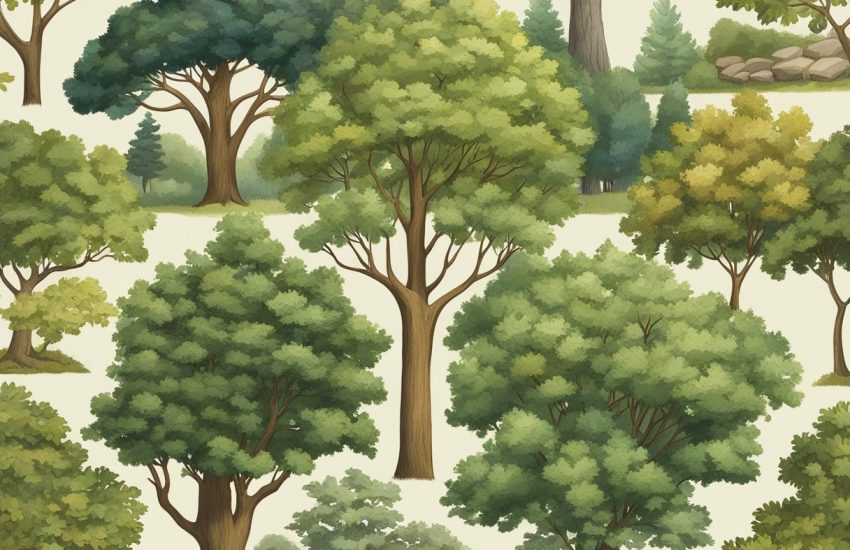The Best Ornamental Trees for Every Texas Region
The varied landscape across Texas makes it a unique state to grow ornamental trees, and those thriving in one area may do poorly in another. Therefore, consider the different regions of the Lone Star state when choosing ornamental trees.
Big Bend Region Ornamental Trees
Far west Texas, including the city of El Paso, is the Big Bend Region. Since this area only gets about 10 inches of rain annually, choosing trees that do not require much water is imperative.
Mexican Redbud (Cercis canadensis var. Mexicana)
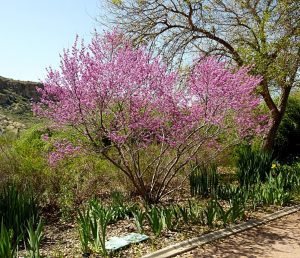
The Mexican Redbud generally stays under 12 feet tall in this region, although they grow up to 25 feet tall in Mexico. Hundreds of purple pea-like flowers appear in the early spring, followed by 1-to-3-inch pods. While these pods start out green, they turn brown in the fall. They can be hard to spot because this tree has an abundance of glossy green leaves with a wavy edge that are between 2 and 4 inches long. They turn a golden brown in the autumn.
This tree does not require much water and needs to be aggressively pruned if a single-trunk tree is desired as it naturally grows into a vase shape with multiple trunks. This tree loves full sun and thrives in sandy soil.
Texas Pistache (Pistacia mexicana)
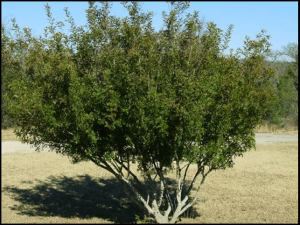
Texas Pistache is an evergreen ornamental tree that grows between 12 and 20 feet tall. While this tree loves well-drained soil, it thrives in areas where there is a lot of limestone. If it is not pruned, it will have multiple trunks. In the spring, female Texas pistache trees produce white flowers, which last until the hottest summer days. These flowers that are usually less than 1 inch long are followed by red berry clusters that gradually turn black in the fall as the berries dry, and birds find them delicious. This tree is a showstopper even on males because of its many small leaves with bronze growing tips.
In addition to the fact that it will grow in areas filled with limestone, it is very heat tolerant and has very low watering requirements. Additionally, this tree is salt tolerant.
Panhandle Plains Ornamental Trees
The Texas Panhandle region, including Amarillo, has extreme temperatures. While the average temperature in January is 29 degrees, temperatures often top 95 degrees in the summer.
Texas Mountain Laurel (Sophora secundiflora)
s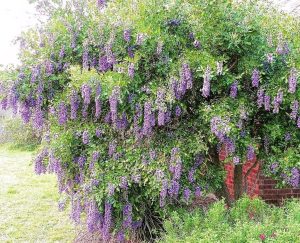
Texas Mountain Laurel is often grown as a shrub but can be pruned as a small tree. Typically, it grows to be 10 to 15 feet tall, but it may stay shorter than that or reach up to 30 feet tall. Fragrant bluish-lavender flowers appear in clusters ranging from 3 to 7 inches long in the early spring. Some people describe the blossoms as smelling like grape Kool-Aide. Butterflies and bees are especially attracted to the Frangrance of this tree’s blooms. Then, this tree puts on seedpods with a unique felt-like texture. If the seedpods break open, there are crimson red seeds inside. The dark-green leaves growing on this evergreen tree are comprised of seven to nine glossy leaflets along a single axis and terminating with a single leaflet.
Texas mountain laurel is very drought tolerant. These trees do well in well-drained alkaline soil, but they are very tolerant of clay and limestone soil. This plant loves the sun.
Crape Myrtle (Lagerstroemia indica)
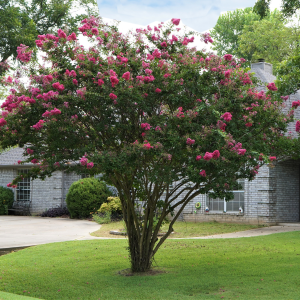
While many prune the crape myrtle to be smaller, it will naturally grow to be about 20 feet tall and 15 feet wide and has a vase-shaped crown. When most springtime flowers in the panhandle are dying, this tree produces beautiful clusters of flowers that last into the fall. There are several varieties of this tree, so some bloom white while others bloom pink or purple. Regardless of the color, each flower looks like it was made from crape paper. Each has six petals and style-like staminodes. Springtime leaves on this tree are dark green with a red tinge, but in the fall, the leaves that are about 2 inches long turn yellow, orange and red. Crepe myrtle bark tends to shed in strips. While the outside of the tree is usually a light brown, once the tree begins to peel, it reveals red, cream and orange bark underneath. During the winter, the tree’s trunk becomes smooth again, and the process is repeated during the next growing season.
Crape myrtle trees prefer full sun, but they will tolerate some shade. They prefer neutral or slightly acidic soils but will tolerate alkaline soils.
Hill Country Ornamental Trees
While the Texas Hill Country is best known for its bluebonnets, many ornamental trees thrive in this area surrounding Fredericksburg and Austin.
Mexican Plum (Prunus mexicana)

Mexican plum trees grow to be between 15 and 35 feet tall. Hundreds of tiny white flowers appear in the early spring before it even leaves out. Depending on the weather, it is not unusual to see a Mexican plum blooming in the Hill Country in February. Very similar to cherry blossom blooms, each Mexican plum bloom is about 1-inch wide and only has two parts. The tree produces a honey-like fragrance while it is blooming. This tree will drop its deciduous leaves in the fall, but because of how early it blooms, it is never bare for long. The bark on a mature tree exfoliates, leaving dark bluish-purple-gray stripes on the tree.
It will produce plums some years, depending on the weather, which are great for cooking and making jelly. Additionally, the plums change color from spring to fall, adding another element of visual interest. This tree prefers well-drained soils, and it does well in sandy and clay soils.
Retama (Parkinsonia aculeata)
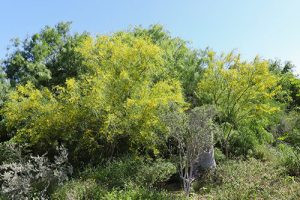
Retama can grow up to 30 feet tall but typically matures at about 15 feet. This tree puts on many five yellow-petaled blossoms, but one of the blossoms has a honey gland, and it will soon turn red. This ornamental tree continues to produce new blooms from April through late August if it keeps raining. Each blossom is about 1.5 inches long. This tree also produces light-green seedpods that grow to be about 4 inches long. Each light-green leaf consists of two parallel stems about 18 inches long and has up to 25 4-inch-long leaflets giving this tree a fountainlike appearance.
This tree grows quickly, even in poor soil, and it tolerates heat, drought and saline very well, although it will lose all its leaves if it gets too dry. Landscapers need to be careful when choosing a location for this attractive option because it does have thorns, which is why this tree is sometimes called the Jerusalem thorn tree.
Prairies and Lakes Ornamental Trees
The Texas prairies and lakes region cover a large portion of north Texas, including the Dallas-Fort Worth area.
Eve’s Necklace (Styphnolobium affine)
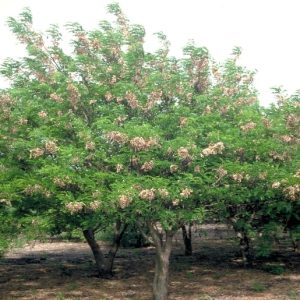
Eve’s necklace is a spineless tree producing clusters of flowers in March, and it will continue to bloom until Memorial Day. The flowers are about the size of a pea and have a bell shape. They are usually pink, although white varieties exist. After the flowers fade, this tree produces hundreds of seedpods about 1 inch long. These pods give this tree its name because they appear to be strung together like a necklace along the tree’s branches. Eve’s necklace also has glossy compound leaves that start out light green before turning orange-yellow in the fall. While new branches are light brown, the mature wood on this tree is reddish-brown, providing an interesting contrast.
This deciduous tree grows well in all soil types, including sand, if well drained. Many people collect the pods because they can be messy if allowed to drop. Prune this tree in late winter, or it can look spindly.
Flowering Dogwood (Cornus florida)
The flowering dogwood tree can grow to be 40 feet tall, but most grow to be about 20 feet tall. Young trees have a rounded form, but mature trees have a flat crown. In the early spring, this tree produces bracts that turn into white or pink flowers. After the flowers disappear, small red berries usually appear in clusters of up to 10, with each one growing to be about 12 inches long. The fruit ripens in autumn, with some remaining on the tree throughout the winter. Mature bark has bold patterns, ranging from gray to reddish-brown. The oval leaves on this tree grow to be about 4.5 inches long and 2 inches wide. They are bright green in the summer but turn bright orange in the fall.
Flowering dogwood trees do well in full sun or partial shade. This tree must be planted in well-drained soil to prevent dogwood anthracnose. This tree does not like to be pruned.
South Texas Ornamental Trees
South Texas consists of the Rio Grande Valley and the Texas Gulf Coast, and it is the most humid area of the state.
Huisache
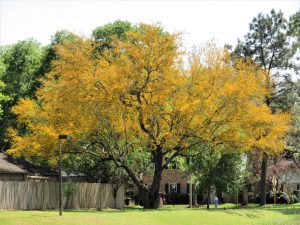
Often called the sweet acacia tree, huisache trees grow up to 30 feet tall and often grow as wide as they do tall. The bright yellow fragrant blooms appearing in February are a welcome sign that spring is on its way. Each flower has a ball shape, and the entire tree may look like a big fluffball. After the flowers fade in May, this tree produces brownish seedpods that are about 3 inches long and tapered on both ends. Each tree has multiple thorns that can be up to 2 inches long.
This tree can take Texas heat, but landscapers should keep it away from reflective surfaces. It prefers well-drained soils. It is an excellent option for many South Texas locations because it loves the sun.
Piney Woods Ornamental Trees
The Piney Woods of East Texas, including the cities of Beaumont, Longview and Nacogdoches, sees more rainfall than other areas of the state, which is an essential factor to consider when choosing ornamental trees.
Cherry Laurel (Prunus laurocerasus)

The cherry laurel evergreen is a fantastic Piney Woods ornamental tree that usually grows about 20 feet tall and 8 feet wide. Its leathery green leaves often grow up to 7 inches long and 2 inches wide, and they smell like maraschino cherries when bruised. While the flowers can sometimes be hard to see because of this tree’s abundant foliage, it produces white flowers in mid-spring. Each white flower is about 3/16 inches wide and grows in small clusters of about 40 flowers. This tree’s fruit starts out red and grows to have about a ¾-inch diameter before turning black when mature.
This tree loves clay and sandy, well-drained soil. It will tolerate rainy periods but does not like constantly flooded conditions.
Possumhaw Holly (Ilex decidua)
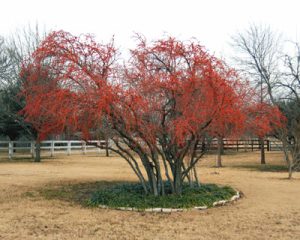
Possumhaw holly trees grow to be about 30 feet tall, and it has thin branches. It produces white flowers in March that gradually become yellowish throughout the spring. Then, female trees produce red berries that stay on the tree until the following spring. The simple leaves on this tree are dark green throughout most of the year before turning yellow in the fall. Unlike some holly trees, this option loses its leaves in the winter, allowing the bright red fruit to create an interesting contrast with the gray branches throughout the winter months.
Birds find the berries very delicious in the winter when food can be hard to find. This tree is very tolerant of having too much water. It also handles pollution and salt very well.


